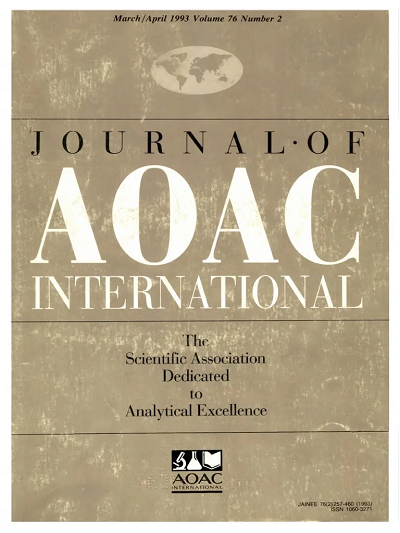增强环保型电位离子选择电极在稳定指示型乙醯胺测量中的可持续性:在散装和药物制剂中的应用
IF 1.7
4区 农林科学
Q3 CHEMISTRY, ANALYTICAL
引用次数: 0
摘要
背景 科学家需要通过使用可持续和绿色化学概念来减少废物、节约能源并开发危险化合物的安全替代品,从而保护和造福社会与环境。目的 制作四种新型环保离子选择电极(ISE),用于测定散装粉末和不同药物制剂中的乙醯胺(ETM)。经过制作和评估,本电极可将 ETM 与各种无机、有机离子、糖类、一些常见药用辅料以及 ETM 的降解产物对苯二酚 (HQ) 明确区分开来,因此可用于稳定性指示方法。方法 电极的制作以 2-硝基苯辛基醚(NPOE)为基础,在聚氯乙烯(PVC)聚合物基质中,电极 1、2 和 3 使用 NPOE 作为增塑剂,但电极 4 使用癸二酸二丁酯作为增塑剂。电极 1 和 2 的制作使用了四十二烷基溴化铵作为阴离子交换剂,仅在电极 2 中加入了 4-磺基-8-烯作为离子载体,但电极 1 的制作没有加入离子载体。电极 3 & 4 的制备基于聚氯乙烯基质中的离子结合复合物乙醯胺四苯基硼酸酯(ETM-TPB)。使用绿色分析程序指数(GAPI)和样品制备分析绿色度量(AGREEprep)对环境可持续性进行了评估。结果 1 号和 2 号电极的线性动态范围分别为 (10-1-10 -5) 和 (10-1-10 -4),Nernstian 斜率分别为 49.6 和 53.2 mV/decade。电极 3 & 4 的线性动态范围为 (10-1-10 -4),内氏斜率分别为 43.9 和 40.2 mV/分。结论 生成电极的选择性系数显示了对 ETM 的良好选择性。与其他电极相比,4-sulfocalix-8-arene 作为离子源对提高电极 2 的膜灵敏度和选择性有显著影响。本文章由计算机程序翻译,如有差异,请以英文原文为准。
Enhancing the Sustainability of Eco-friendly Potentiometric Ion Selective Electrodes for Stability-Indicating Measurement of Ethamsylate: Application in Bulk and Pharmaceutical Formulations
Background Through the use of sustainable and green chemistry concepts, scientists need to decrease waste, conserve energy, and develop safe substitutes for hazardous compounds, all for protecting and benefiting society and the environment. Objective Four novel eco-friendly ion selective electrodes (ISE) were created to determine Ethamsylate (ETM) in bulk powder and different pharmaceutical formulations. The present electrodes were fabricated and evaluated to clearly distinguish ETM from a variety of inorganic, organic ions, sugars, some common drug excipients and the degradation product, hydroquinone (HQ) of ETM, and thus could be used for stability-indicating methods. Methods The electrodes fabrication was based on 2-nitrophenyl octyl ether (NPOE) that was employed as a plasticizer in electrodes 1, 2, and 3 within a polymeric matrix of polyvinyl chloride (PVC) except for electrode 4, in which dibutyl sebacate was used as a plasticizer. Electrodes 1 & 2 were fabricated using tetra dodecyl ammonium bromide as an anionic exchanger and adding 4-sulfocalix-8-arene as an ionophore only to electrode 2, but electrode 1 prepared without incorporation of an ionophore. The fabrication of electrodes 3 & 4 was based on ethamsylate-tetraphenylborate (ETM-TPB) as an ion-association complex in a PVC matrix. The environmental sustainability was assessed using Green Analytical Procedure Index (GAPI), and Analytical Greenness Metric for Sample Preparation (AGREEprep). Results Electrodes 1 & 2 had linear dynamic ranges of (10−1—10 −5) and (10−1—10 −4) respectively, with a Nernstian slope of 49.6 and 53.2 mV/decade, respectively. Electrodes 3 & 4 had linear dynamic ranges of (10−1—10 −4), with a Nernstian slope of 43.9 and 40.2 mV/decade, respectively. Conclusion The generated electrodes' selectivity coefficients showed good selectivity for ETM. The utility 4-sulfocalix-8-arene as ionophore had a significant influence on increasing the membrane sensitivity and selectivity of electrode 2 compared to other electrodes.
求助全文
通过发布文献求助,成功后即可免费获取论文全文。
去求助
来源期刊

Journal of AOAC International
医学-分析化学
CiteScore
3.10
自引率
12.50%
发文量
144
审稿时长
2.7 months
期刊介绍:
The Journal of AOAC INTERNATIONAL publishes the latest in basic and applied research in analytical sciences related to foods, drugs, agriculture, the environment, and more. The Journal is the method researchers'' forum for exchanging information and keeping informed of new technology and techniques pertinent to regulatory agencies and regulated industries.
 求助内容:
求助内容: 应助结果提醒方式:
应助结果提醒方式:


